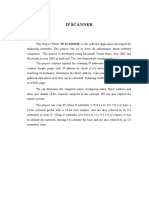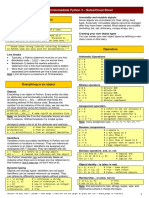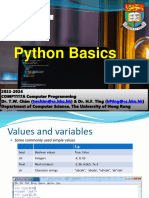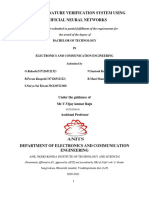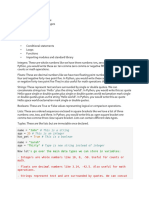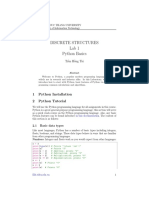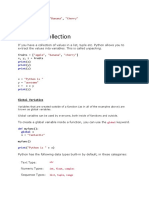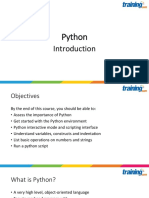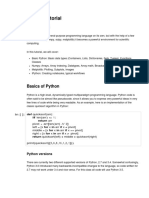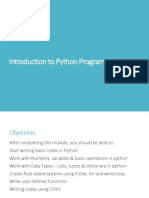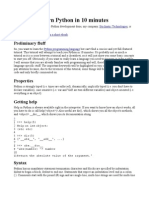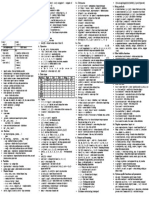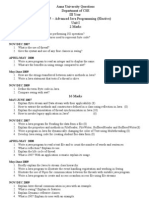Learn Python in Y Minutes
Uploaded by
testingtestexploreLearn Python in Y Minutes
Uploaded by
testingtestexploreLearn X in Y minutes (/)
Where X=Python
Language: English
Get the code: learnpython.py (/files/learnpython.py)
Python was created by Guido van Rossum in the early 90s. It is now one of the most
popular languages in existence. I fell in love with Python for its syntactic clarity. It's
basically executable pseudocode.
# Single line comments start with a number symbol.
""" Multiline strings can be written
using three "s, and are often used
as documentation.
"""
####################################################
## 1. Primitive Datatypes and Operators
####################################################
# You have numbers
3 # => 3
# Math is what you would expect
1 + 1 # => 2
8 - 1 # => 7
10 * 2 # => 20
35 / 5 # => 7.0
# Floor division rounds towards negative infinity
5 // 3 # => 1
-5 // 3 # => -2
5.0 // 3.0 # => 1.0 # works on floats too
-5.0 // 3.0 # => -2.0
# The result of division is always a float
10.0 / 3 # => 3.3333333333333335
# Modulo operation
7 % 3 # => 1
# i % j have the same sign as j, unlike C
-7 % 3 # => 2
# Exponentiation (x**y, x to the yth power)
2**3 # => 8
# Enforce precedence with parentheses
1 + 3 * 2 # => 7
(1 + 3) * 2 # => 8
# Boolean values are primitives (Note: the capitalization)
True # => True
False # => False
# negate with not
not True # => False
not False # => True
# Boolean Operators
# Note "and" and "or" are case-sensitive
True and False # => False
False or True # => True
# True and False are actually 1 and 0 but with different keywords
True + True # => 2
True * 8 # => 8
False - 5 # => -5
# Comparison operators look at the numerical value of True and False
0 == False # => True
2 > True # => True
2 == True # => False
-5 != False # => True
# None, 0, and empty strings/lists/dicts/tuples/sets all evaluate to False.
# All other values are True
bool(0) # => False
bool("") # => False
bool([]) # => False
bool({}) # => False
bool(()) # => False
bool(set()) # => False
bool(4) # => True
bool(-6) # => True
# Using boolean logical operators on ints casts them to booleans for evaluati
# but their non-cast value is returned. Don't mix up with bool(ints) and bitw
# and/or (&,|)
bool(0) # => False
bool(2) # => True
0 and 2 # => 0
bool(-5) # => True
bool(2) # => True
-5 or 0 # => -5
# Equality is ==
1 == 1 # => True
2 == 1 # => False
# Inequality is !=
1 != 1 # => False
2 != 1 # => True
# More comparisons
1 < 10 # => True
1 > 10 # => False
2 <= 2 # => True
2 >= 2 # => True
# Seeing whether a value is in a range
1 < 2 and 2 < 3 # => True
2 < 3 and 3 < 2 # => False
# Chaining makes this look nicer
1 < 2 < 3 # => True
2 < 3 < 2 # => False
# (is vs. ==) is checks if two variables refer to the same object, but == che
# if the objects pointed to have the same values.
a = [1, 2, 3, 4] # Point a at a new list, [1, 2, 3, 4]
b = a # Point b at what a is pointing to
b is a # => True, a and b refer to the same object
b == a # => True, a's and b's objects are equal
b = [1, 2, 3, 4] # Point b at a new list, [1, 2, 3, 4]
b is a # => False, a and b do not refer to the same object
b == a # => True, a's and b's objects are equal
# Strings are created with " or '
"This is a string."
'This is also a string.'
# Strings can be added too
"Hello " + "world!" # => "Hello world!"
# String literals (but not variables) can be concatenated without using '+'
"Hello " "world!" # => "Hello world!"
# A string can be treated like a list of characters
"Hello world!"[0] # => 'H'
# You can find the length of a string
len("This is a string") # => 16
# Since Python 3.6, you can use f-strings or formatted string literals.
name = "Reiko"
f"She said her name is {name}." # => "She said her name is Reiko"
# Any valid Python expression inside these braces is returned to the string.
f"{name} is {len(name)} characters long." # => "Reiko is 5 characters long."
# None is an object
None # => None
# Don't use the equality "==" symbol to compare objects to None
# Use "is" instead. This checks for equality of object identity.
"etc" is None # => False
None is None # => True
####################################################
## 2. Variables and Collections
####################################################
# Python has a print function
print("I'm Python. Nice to meet you!") # => I'm Python. Nice to meet you!
# By default the print function also prints out a newline at the end.
# Use the optional argument end to change the end string.
print("Hello, World", end="!") # => Hello, World!
# Simple way to get input data from console
input_string_var = input("Enter some data: ") # Returns the data as a string
# There are no declarations, only assignments.
# Convention in naming variables is snake_case style
some_var = 5
some_var # => 5
# Accessing a previously unassigned variable is an exception.
# See Control Flow to learn more about exception handling.
some_unknown_var # Raises a NameError
# if can be used as an expression
# Equivalent of C's '?:' ternary operator
"yay!" if 0 > 1 else "nay!" # => "nay!"
# Lists store sequences
li = []
# You can start with a prefilled list
other_li = [4, 5, 6]
# Add stuff to the end of a list with append
li.append(1) # li is now [1]
li.append(2) # li is now [1, 2]
li.append(4) # li is now [1, 2, 4]
li.append(3) # li is now [1, 2, 4, 3]
# Remove from the end with pop
li.pop() # => 3 and li is now [1, 2, 4]
# Let's put it back
li.append(3) # li is now [1, 2, 4, 3] again.
# Access a list like you would any array
li[0] # => 1
# Look at the last element
li[-1] # => 3
# Looking out of bounds is an IndexError
li[4] # Raises an IndexError
# You can look at ranges with slice syntax.
# The start index is included, the end index is not
# (It's a closed/open range for you mathy types.)
li[1:3] # Return list from index 1 to 3 => [2, 4]
li[2:] # Return list starting from index 2 => [4, 3]
li[:3] # Return list from beginning until index 3 => [1, 2, 4]
li[::2] # Return list selecting elements with a step size of 2 => [1, 4]
li[::-1] # Return list in reverse order => [3, 4, 2, 1]
# Use any combination of these to make advanced slices
# li[start:end:step]
# Make a one layer deep copy using slices
li2 = li[:] # => li2 = [1, 2, 4, 3] but (li2 is li) will result in false.
# Remove arbitrary elements from a list with "del"
del li[2] # li is now [1, 2, 3]
# Remove first occurrence of a value
li.remove(2) # li is now [1, 3]
li.remove(2) # Raises a ValueError as 2 is not in the list
# Insert an element at a specific index
li.insert(1, 2) # li is now [1, 2, 3] again
# Get the index of the first item found matching the argument
li.index(2) # => 1
li.index(4) # Raises a ValueError as 4 is not in the list
# You can add lists
# Note: values for li and for other_li are not modified.
li + other_li # => [1, 2, 3, 4, 5, 6]
# Concatenate lists with "extend()"
li.extend(other_li) # Now li is [1, 2, 3, 4, 5, 6]
# Check for existence in a list with "in"
1 in li # => True
# Examine the length with "len()"
len(li) # => 6
# Tuples are like lists but are immutable.
tup = (1, 2, 3)
tup[0] # => 1
tup[0] = 3 # Raises a TypeError
# Note that a tuple of length one has to have a comma after the last element
# tuples of other lengths, even zero, do not.
type((1)) # => <class 'int'>
type((1,)) # => <class 'tuple'>
type(()) # => <class 'tuple'>
# You can do most of the list operations on tuples too
len(tup) # => 3
tup + (4, 5, 6) # => (1, 2, 3, 4, 5, 6)
tup[:2] # => (1, 2)
2 in tup # => True
# You can unpack tuples (or lists) into variables
a, b, c = (1, 2, 3) # a is now 1, b is now 2 and c is now 3
# You can also do extended unpacking
a, *b, c = (1, 2, 3, 4) # a is now 1, b is now [2, 3] and c is now 4
# Tuples are created by default if you leave out the parentheses
d, e, f = 4, 5, 6 # tuple 4, 5, 6 is unpacked into variables d, e and f
# respectively such that d = 4, e = 5 and f = 6
# Now look how easy it is to swap two values
e, d = d, e # d is now 5 and e is now 4
# Dictionaries store mappings from keys to values
empty_dict = {}
# Here is a prefilled dictionary
filled_dict = {"one": 1, "two": 2, "three": 3}
# Note keys for dictionaries have to be immutable types. This is to ensure th
# the key can be converted to a constant hash value for quick look-ups.
# Immutable types include ints, floats, strings, tuples.
invalid_dict = {[1,2,3]: "123"} # => Yield a TypeError: unhashable type: 'li
valid_dict = {(1,2,3):[1,2,3]} # Values can be of any type, however.
# Look up values with []
filled_dict["one"] # => 1
# Get all keys as an iterable with "keys()". We need to wrap the call in list
# to turn it into a list. We'll talk about those later. Note - for Python
# versions <3.7, dictionary key ordering is not guaranteed. Your results migh
# not match the example below exactly. However, as of Python 3.7, dictionary
# items maintain the order at which they are inserted into the dictionary.
list(filled_dict.keys()) # => ["three", "two", "one"] in Python <3.7
list(filled_dict.keys()) # => ["one", "two", "three"] in Python 3.7+
# Get all values as an iterable with "values()". Once again we need to wrap i
# in list() to get it out of the iterable. Note - Same as above regarding key
# ordering.
list(filled_dict.values()) # => [3, 2, 1] in Python <3.7
list(filled_dict.values()) # => [1, 2, 3] in Python 3.7+
# Check for existence of keys in a dictionary with "in"
"one" in filled_dict # => True
1 in filled_dict # => False
# Looking up a non-existing key is a KeyError
filled_dict["four"] # KeyError
# Use "get()" method to avoid the KeyError
filled_dict.get("one") # => 1
filled_dict.get("four") # => None
# The get method supports a default argument when the value is missing
filled_dict.get("one", 4) # => 1
filled_dict.get("four", 4) # => 4
# "setdefault()" inserts into a dictionary only if the given key isn't presen
filled_dict.setdefault("five", 5) # filled_dict["five"] is set to 5
filled_dict.setdefault("five", 6) # filled_dict["five"] is still 5
# Adding to a dictionary
filled_dict.update({"four":4}) # => {"one": 1, "two": 2, "three": 3, "four":
filled_dict["four"] = 4 # another way to add to dict
# Remove keys from a dictionary with del
del filled_dict["one"] # Removes the key "one" from filled dict
# From Python 3.5 you can also use the additional unpacking options
{"a": 1, **{"b": 2}} # => {'a': 1, 'b': 2}
{"a": 1, **{"a": 2}} # => {'a': 2}
# Sets store ... well sets
empty_set = set()
# Initialize a set with a bunch of values.
some_set = {1, 1, 2, 2, 3, 4} # some_set is now {1, 2, 3, 4}
# Similar to keys of a dictionary, elements of a set have to be immutable.
invalid_set = {[1], 1} # => Raises a TypeError: unhashable type: 'list'
valid_set = {(1,), 1}
# Add one more item to the set
filled_set = some_set
filled_set.add(5) # filled_set is now {1, 2, 3, 4, 5}
# Sets do not have duplicate elements
filled_set.add(5) # it remains as before {1, 2, 3, 4, 5}
# Do set intersection with &
other_set = {3, 4, 5, 6}
filled_set & other_set # => {3, 4, 5}
# Do set union with |
filled_set | other_set # => {1, 2, 3, 4, 5, 6}
# Do set difference with -
{1, 2, 3, 4} - {2, 3, 5} # => {1, 4}
# Do set symmetric difference with ^
{1, 2, 3, 4} ^ {2, 3, 5} # => {1, 4, 5}
# Check if set on the left is a superset of set on the right
{1, 2} >= {1, 2, 3} # => False
# Check if set on the left is a subset of set on the right
{1, 2} <= {1, 2, 3} # => True
# Check for existence in a set with in
2 in filled_set # => True
10 in filled_set # => False
# Make a one layer deep copy
filled_set = some_set.copy() # filled_set is {1, 2, 3, 4, 5}
filled_set is some_set # => False
####################################################
## 3. Control Flow and Iterables
####################################################
# Let's just make a variable
some_var = 5
# Here is an if statement. Indentation is significant in Python!
# Convention is to use four spaces, not tabs.
# This prints "some_var is smaller than 10"
if some_var > 10:
print("some_var is totally bigger than 10.")
elif some_var < 10: # This elif clause is optional.
print("some_var is smaller than 10.")
else: # This is optional too.
print("some_var is indeed 10.")
# Match/Case — Introduced in Python 3.10
# It compares a value against multiple patterns and executes the matching cas
command = "run"
match command:
🏃♂️
case "run":
print("The robot started to run ")
🗣️
case "speak" | "say_hi": # multiple options (OR pattern)
print("The robot said hi ")
case code if command.isdigit(): # conditional
print(f"The robot execute code: {code}")
❌
case _: # _ is a wildcard that never fails (like default/else)
print("Invalid command ")
# Output: "the robot started to run 🏃♂️"
"""
For loops iterate over lists
prints:
dog is a mammal
cat is a mammal
mouse is a mammal
"""
for animal in ["dog", "cat", "mouse"]:
# You can use format() to interpolate formatted strings
print("{} is a mammal".format(animal))
"""
"range(number)" returns an iterable of numbers
from zero up to (but excluding) the given number
prints:
0
1
2
3
"""
for i in range(4):
print(i)
"""
"range(lower, upper)" returns an iterable of numbers
from the lower number to the upper number
prints:
4
5
6
7
"""
for i in range(4, 8):
print(i)
"""
"range(lower, upper, step)" returns an iterable of numbers
from the lower number to the upper number, while incrementing
by step. If step is not indicated, the default value is 1.
prints:
4
6
"""
for i in range(4, 8, 2):
print(i)
"""
Loop over a list to retrieve both the index and the value of each list item:
0 dog
1 cat
2 mouse
"""
animals = ["dog", "cat", "mouse"]
for i, value in enumerate(animals):
print(i, value)
"""
While loops go until a condition is no longer met.
prints:
0
1
2
3
"""
x = 0
while x < 4:
print(x)
x += 1 # Shorthand for x = x + 1
# Handle exceptions with a try/except block
try:
# Use "raise" to raise an error
raise IndexError("This is an index error")
except IndexError as e:
pass # Refrain from this, provide a recovery (next exampl
except (TypeError, NameError):
pass # Multiple exceptions can be processed jointly.
else: # Optional clause to the try/except block. Must foll
# all except blocks.
print("All good!") # Runs only if the code in try raises no exceptions
finally: # Execute under all circumstances
print("We can clean up resources here")
# Instead of try/finally to cleanup resources you can use a with statement
with open("myfile.txt") as f:
for line in f:
print(line)
# Writing to a file
contents = {"aa": 12, "bb": 21}
with open("myfile1.txt", "w") as file:
file.write(str(contents)) # writes a string to a file
import json
with open("myfile2.txt", "w") as file:
file.write(json.dumps(contents)) # writes an object to a file
# Reading from a file
with open("myfile1.txt") as file:
contents = file.read() # reads a string from a file
print(contents)
# print: {"aa": 12, "bb": 21}
with open("myfile2.txt", "r") as file:
contents = json.load(file) # reads a json object from a file
print(contents)
# print: {"aa": 12, "bb": 21}
# Python offers a fundamental abstraction called the Iterable.
# An iterable is an object that can be treated as a sequence.
# The object returned by the range function, is an iterable.
filled_dict = {"one": 1, "two": 2, "three": 3}
our_iterable = filled_dict.keys()
print(our_iterable) # => dict_keys(['one', 'two', 'three']). This is an obje
# that implements our Iterable interface.
# We can loop over it.
for i in our_iterable:
print(i) # Prints one, two, three
# However we cannot address elements by index.
our_iterable[1] # Raises a TypeError
# An iterable is an object that knows how to create an iterator.
our_iterator = iter(our_iterable)
# Our iterator is an object that can remember the state as we traverse throug
# it. We get the next object with "next()".
next(our_iterator) # => "one"
# It maintains state as we iterate.
next(our_iterator) # => "two"
next(our_iterator) # => "three"
# After the iterator has returned all of its data, it raises a
# StopIteration exception
next(our_iterator) # Raises StopIteration
# We can also loop over it, in fact, "for" does this implicitly!
our_iterator = iter(our_iterable)
for i in our_iterator:
print(i) # Prints one, two, three
# You can grab all the elements of an iterable or iterator by call of list().
list(our_iterable) # => Returns ["one", "two", "three"]
list(our_iterator) # => Returns [] because state is saved
####################################################
## 4. Functions
####################################################
# Use "def" to create new functions
def add(x, y):
print("x is {} and y is {}".format(x, y))
return x + y # Return values with a return statement
# Calling functions with parameters
add(5, 6) # => prints out "x is 5 and y is 6" and returns 11
# Another way to call functions is with keyword arguments
add(y=6, x=5) # Keyword arguments can arrive in any order.
# You can define functions that take a variable number of
# positional arguments
def varargs(*args):
return args
varargs(1, 2, 3) # => (1, 2, 3)
# You can define functions that take a variable number of
# keyword arguments, as well
def keyword_args(**kwargs):
return kwargs
# Let's call it to see what happens
keyword_args(big="foot", loch="ness") # => {"big": "foot", "loch": "ness"}
# You can do both at once, if you like
def all_the_args(*args, **kwargs):
print(args)
print(kwargs)
"""
all_the_args(1, 2, a=3, b=4) prints:
(1, 2)
{"a": 3, "b": 4}
"""
# When calling functions, you can do the opposite of args/kwargs!
# Use * to expand args (tuples) and use ** to expand kwargs (dictionaries).
args = (1, 2, 3, 4)
kwargs = {"a": 3, "b": 4}
all_the_args(*args) # equivalent: all_the_args(1, 2, 3, 4)
all_the_args(**kwargs) # equivalent: all_the_args(a=3, b=4)
all_the_args(*args, **kwargs) # equivalent: all_the_args(1, 2, 3, 4, a=3, b=
# Returning multiple values (with tuple assignments)
def swap(x, y):
return y, x # Return multiple values as a tuple without the parenthesis.
# (Note: parenthesis have been excluded but can be included)
x = 1
y = 2
x, y = swap(x, y) # => x = 2, y = 1
# (x, y) = swap(x,y) # Again the use of parenthesis is optional.
# global scope
x = 5
def set_x(num):
# local scope begins here
# local var x not the same as global var x
x = num # => 43
print(x) # => 43
def set_global_x(num):
# global indicates that particular var lives in the global scope
global x
print(x) # => 5
x = num # global var x is now set to 6
print(x) # => 6
set_x(43)
set_global_x(6)
"""
prints:
43
5
6
"""
# Python has first class functions
def create_adder(x):
def adder(y):
return x + y
return adder
add_10 = create_adder(10)
add_10(3) # => 13
# Closures in nested functions:
# We can use the nonlocal keyword to work with variables in nested scope whic
def create_avg():
total = 0
count = 0
def avg(n):
nonlocal total, count
total += n
count += 1
return total/count
return avg
avg = create_avg()
avg(3) # => 3.0
avg(5) # (3+5)/2 => 4.0
avg(7) # (8+7)/3 => 5.0
# There are also anonymous functions
(lambda x: x > 2)(3) # => True
(lambda x, y: x ** 2 + y ** 2)(2, 1) # => 5
# There are built-in higher order functions
list(map(add_10, [1, 2, 3])) # => [11, 12, 13]
list(map(max, [1, 2, 3], [4, 2, 1])) # => [4, 2, 3]
list(filter(lambda x: x > 5, [3, 4, 5, 6, 7])) # => [6, 7]
# We can use list comprehensions for nice maps and filters
# List comprehension stores the output as a list (which itself may be nested)
[add_10(i) for i in [1, 2, 3]] # => [11, 12, 13]
[x for x in [3, 4, 5, 6, 7] if x > 5] # => [6, 7]
# You can construct set and dict comprehensions as well.
{x for x in "abcddeef" if x not in "abc"} # => {'d', 'e', 'f'}
{x: x**2 for x in range(5)} # => {0: 0, 1: 1, 2: 4, 3: 9, 4: 16}
####################################################
## 5. Modules
####################################################
# You can import modules
import math
print(math.sqrt(16)) # => 4.0
# You can get specific functions from a module
from math import ceil, floor
print(ceil(3.7)) # => 4
print(floor(3.7)) # => 3
# You can import all functions from a module.
# Warning: this is not recommended
from math import *
# You can shorten module names
import math as m
math.sqrt(16) == m.sqrt(16) # => True
# Python modules are just ordinary Python files. You
# can write your own, and import them. The name of the
# module is the same as the name of the file.
# You can find out which functions and attributes
# are defined in a module.
import math
dir(math)
# If you have a Python script named math.py in the same
# folder as your current script, the file math.py will
# be loaded instead of the built-in Python module.
# This happens because the local folder has priority
# over Python's built-in libraries.
####################################################
## 6. Classes
####################################################
# We use the "class" statement to create a class
class Human:
# A class attribute. It is shared by all instances of this class
species = "H. sapiens"
# Basic initializer, this is called when this class is instantiated.
# Note that the double leading and trailing underscores denote objects
# or attributes that are used by Python but that live in user-controlled
# namespaces. Methods(or objects or attributes) like: __init__, __str__,
# __repr__ etc. are called special methods (or sometimes called dunder
# methods). You should not invent such names on your own.
def __init__(self, name):
# Assign the argument to the instance's name attribute
self.name = name
# Initialize property
self._age = 0 # the leading underscore indicates the "age" property
# intended to be used internally
# do not rely on this to be enforced: it's a hint to
# An instance method. All methods take "self" as the first argument
def say(self, msg):
print("{name}: {message}".format(name=self.name, message=msg))
# Another instance method
def sing(self):
return "yo... yo... microphone check... one two... one two..."
# A class method is shared among all instances
# They are called with the calling class as the first argument
@classmethod
def get_species(cls):
return cls.species
# A static method is called without a class or instance reference
@staticmethod
def grunt():
return "*grunt*"
# A property is just like a getter.
# It turns the method age() into a read-only attribute of the same name.
# There's no need to write trivial getters and setters in Python, though.
@property
def age(self):
return self._age
# This allows the property to be set
@age.setter
def age(self, age):
self._age = age
# This allows the property to be deleted
@age.deleter
def age(self):
del self._age
# When a Python interpreter reads a source file it executes all its code.
# This __name__ check makes sure this code block is only executed when this
# module is the main program.
if __name__ == "__main__":
# Instantiate a class
i = Human(name="Ian")
i.say("hi") # "Ian: hi"
j = Human("Joel")
j.say("hello") # "Joel: hello"
# i and j are instances of type Human; i.e., they are Human objects.
# Call our class method
i.say(i.get_species()) # "Ian: H. sapiens"
# Change the shared attribute
Human.species = "H. neanderthalensis"
i.say(i.get_species()) # => "Ian: H. neanderthalensis"
j.say(j.get_species()) # => "Joel: H. neanderthalensis"
# Call the static method
print(Human.grunt()) # => "*grunt*"
# Static methods can be called by instances too
print(i.grunt()) # => "*grunt*"
# Update the property for this instance
i.age = 42
# Get the property
i.say(i.age) # => "Ian: 42"
j.say(j.age) # => "Joel: 0"
# Delete the property
del i.age
# i.age # => this would raise an AttributeError
####################################################
## 6.1 Inheritance
####################################################
# Inheritance allows new child classes to be defined that inherit methods and
# variables from their parent class.
# Using the Human class defined above as the base or parent class, we can
# define a child class, Superhero, which inherits variables like "species",
# "name", and "age", as well as methods, like "sing" and "grunt"
# from the Human class, but can also have its own unique properties.
# To take advantage of modularization by file you could place the classes abo
# in their own files, say, human.py
# To import functions from other files use the following format
# from "filename-without-extension" import "function-or-class"
from human import Human
# Specify the parent class(es) as parameters to the class definition
class Superhero(Human):
# If the child class should inherit all of the parent's definitions witho
# any modifications, you can just use the "pass" keyword (and nothing els
# but in this case it is commented out to allow for a unique child class:
# pass
# Child classes can override their parents' attributes
species = "Superhuman"
# Children automatically inherit their parent class's constructor includi
# its arguments, but can also define additional arguments or definitions
# and override its methods such as the class constructor.
# This constructor inherits the "name" argument from the "Human" class an
# adds the "superpower" and "movie" arguments:
def __init__(self, name, movie=False,
superpowers=["super strength", "bulletproofing"]):
# add additional class attributes:
self.fictional = True
self.movie = movie
# be aware of mutable default values, since defaults are shared
self.superpowers = superpowers
# The "super" function lets you access the parent class's methods
# that are overridden by the child, in this case, the __init__ method
# This calls the parent class constructor:
super().__init__(name)
# override the sing method
def sing(self):
return "Dun, dun, DUN!"
# add an additional instance method
def boast(self):
for power in self.superpowers:
print("I wield the power of {pow}!".format(pow=power))
if __name__ == "__main__":
sup = Superhero(name="Tick")
# Instance type checks
if isinstance(sup, Human):
print("I am human")
if type(sup) is Superhero:
print("I am a superhero")
# Get the "Method Resolution Order" used by both getattr() and super()
# (the order in which classes are searched for an attribute or method)
# This attribute is dynamic and can be updated
print(Superhero.__mro__) # => (<class '__main__.Superhero'>,
# => <class 'human.Human'>, <class 'object'>)
# Calls parent method but uses its own class attribute
print(sup.get_species()) # => Superhuman
# Calls overridden method
print(sup.sing()) # => Dun, dun, DUN!
# Calls method from Human
sup.say("Spoon") # => Tick: Spoon
# Call method that exists only in Superhero
sup.boast() # => I wield the power of super strength!
# => I wield the power of bulletproofing!
# Inherited class attribute
sup.age = 31
print(sup.age) # => 31
# Attribute that only exists within Superhero
print("Am I Oscar eligible? " + str(sup.movie))
####################################################
## 6.2 Multiple Inheritance
####################################################
# Another class definition
# bat.py
class Bat:
species = "Baty"
def __init__(self, can_fly=True):
self.fly = can_fly
# This class also has a say method
def say(self, msg):
msg = "... ... ..."
return msg
# And its own method as well
def sonar(self):
return "))) ... ((("
if __name__ == "__main__":
b = Bat()
print(b.say("hello"))
print(b.fly)
# And yet another class definition that inherits from Superhero and Bat
# superhero.py
from superhero import Superhero
from bat import Bat
# Define Batman as a child that inherits from both Superhero and Bat
class Batman(Superhero, Bat):
def __init__(self, *args, **kwargs):
# Typically to inherit attributes you have to call super:
# super(Batman, self).__init__(*args, **kwargs)
# However we are dealing with multiple inheritance here, and super()
# only works with the next base class in the MRO list.
# So instead we explicitly call __init__ for all ancestors.
# The use of *args and **kwargs allows for a clean way to pass
# arguments, with each parent "peeling a layer of the onion".
Superhero.__init__(self, "anonymous", movie=True,
superpowers=["Wealthy"], *args, **kwargs)
Bat.__init__(self, *args, can_fly=False, **kwargs)
# override the value for the name attribute
self.name = "Sad Affleck"
def sing(self):
return "nan nan nan nan nan batman!"
if __name__ == "__main__":
sup = Batman()
# The Method Resolution Order
print(Batman.__mro__) # => (<class '__main__.Batman'>,
# => <class 'superhero.Superhero'>,
# => <class 'human.Human'>,
# => <class 'bat.Bat'>, <class 'object'>)
# Calls parent method but uses its own class attribute
print(sup.get_species()) # => Superhuman
# Calls overridden method
print(sup.sing()) # => nan nan nan nan nan batman!
# Calls method from Human, because inheritance order matters
sup.say("I agree") # => Sad Affleck: I agree
# Call method that exists only in 2nd ancestor
print(sup.sonar()) # => ))) ... (((
# Inherited class attribute
sup.age = 100
print(sup.age) # => 100
# Inherited attribute from 2nd ancestor whose default value was overridde
print("Can I fly? " + str(sup.fly)) # => Can I fly? False
####################################################
## 7. Advanced
####################################################
# Generators help you make lazy code.
def double_numbers(iterable):
for i in iterable:
yield i + i
# Generators are memory-efficient because they only load the data needed to
# process the next value in the iterable. This allows them to perform
# operations on otherwise prohibitively large value ranges.
# NOTE: `range` replaces `xrange` in Python 3.
for i in double_numbers(range(1, 900000000)): # `range` is a generator.
print(i)
if i >= 30:
break
# Just as you can create a list comprehension, you can create generator
# comprehensions as well.
values = (-x for x in [1,2,3,4,5])
for x in values:
print(x) # prints -1 -2 -3 -4 -5 to console/terminal
# You can also cast a generator comprehension directly to a list.
values = (-x for x in [1,2,3,4,5])
gen_to_list = list(values)
print(gen_to_list) # => [-1, -2, -3, -4, -5]
# Decorators are a form of syntactic sugar.
# They make code easier to read while accomplishing clunky syntax.
# Wrappers are one type of decorator.
# They're really useful for adding logging to existing functions without need
def log_function(func):
def wrapper(*args, **kwargs):
print("Entering function", func.__name__)
result = func(*args, **kwargs)
print("Exiting function", func.__name__)
return result
return wrapper
@log_function # equivalent:
def my_function(x,y): # def my_function(x,y):
"""Adds two numbers together."""
return x+y # return x+y
# my_function = log_function(my_function)
# The decorator @log_function tells us as we begin reading the function defin
# for my_function that this function will be wrapped with log_function.
# When function definitions are long, it can be hard to parse the non-decorat
# assignment at the end of the definition.
my_function(1,2) # => "Entering function my_function"
# => "3"
# => "Exiting function my_function"
# But there's a problem.
# What happens if we try to get some information about my_function?
print(my_function.__name__) # => 'wrapper'
print(my_function.__doc__) # => None (wrapper function has no docstring)
# Because our decorator is equivalent to my_function = log_function(my_functi
# we've replaced information about my_function with information from wrapper
# Fix this using functools
from functools import wraps
def log_function(func):
@wraps(func) # this ensures docstring, function name, arguments list, et
# to the wrapped function - instead of being replaced with
def wrapper(*args, **kwargs):
print("Entering function", func.__name__)
result = func(*args, **kwargs)
print("Exiting function", func.__name__)
return result
return wrapper
@log_function
def my_function(x,y):
"""Adds two numbers together."""
return x+y
my_function(1,2) # => "Entering function my_function"
# => "3"
# => "Exiting function my_function"
print(my_function.__name__) # => 'my_function'
print(my_function.__doc__) # => 'Adds two numbers together.'
Free Online
Automate the Boring Stuff with Python (https://automatetheboringstuff.com)
The Official Docs (https://docs.python.org/3/)
Hitchhiker's Guide to Python (https://docs.python-guide.org/)
Python Course (https://www.python-course.eu)
First Steps With Python (https://realpython.com/learn/python-first-steps/)
A curated list of awesome Python frameworks, libraries and software
(https://github.com/vinta/awesome-python)
Official Style Guide for Python (https://peps.python.org/pep-0008/)
Python 3 Computer Science Circles (https://cscircles.cemc.uwaterloo.ca/)
Dive Into Python 3 (https://www.diveintopython3.net/)
Python Tutorial for Intermediates (https://pythonbasics.org/)
Build a Desktop App with Python (https://pythonpyqt.com/)
Got a suggestion? A correction, perhaps? Open an Issue
(https://github.com/adambard/learnxinyminutes-docs/issues/new) on the GitHub
Repo, or make a pull request (https://github.com/adambard/learnxinyminutes-
docs/edit/master/python.md) yourself!
Originally contributed by Louie Dinh, and updated by 70 contributors
(https://github.com/adambard/learnxinyminutes-docs/blame/master/python.md).
(https://creativecommons.org/licenses/by-sa/3.0/deed.en_US) © 2025 Louie
Dinh
(http://pythonpracticeprojects.com), Steven Basart (http://github.com/xksteven),
Andre Polykanine (https://github.com/Oire), Zachary Ferguson
(http://github.com/zfergus2), evuez (http://github.com/evuez), Rommel Martinez
(https://ebzzry.io), Roberto Fernandez Diaz (https://github.com/robertofd1995),
caminsha (https://github.com/caminsha), Stanislav Modrak (https://stanislav.gq),
John Paul Wohlscheid (https://gitpi.us)
You might also like
- Guide To Clear Java Developer InterviewNo ratings yetGuide To Clear Java Developer Interview42 pages
- Complete Python Notes - All Topics (Class 11)No ratings yetComplete Python Notes - All Topics (Class 11)16 pages
- CPPROG2 - Lesson 1 Creating Your First Java ClassesNo ratings yetCPPROG2 - Lesson 1 Creating Your First Java Classes15 pages
- Instant Ebooks Textbook Data Structures Other Objects Using Java 4th Edition Michael Mann Download All Chapters100% (16)Instant Ebooks Textbook Data Structures Other Objects Using Java 4th Edition Michael Mann Download All Chapters64 pages
- Python For Data Science, AI & DevelopmentNo ratings yetPython For Data Science, AI & Development10 pages
- The Absolute Basics: Basic and Intermediate Python 3 - Notes/Cheat Sheet100% (3)The Absolute Basics: Basic and Intermediate Python 3 - Notes/Cheat Sheet11 pages
- Object Oriented Programming Lab Manual 1No ratings yetObject Oriented Programming Lab Manual 177 pages
- Offline Signature Verification System Using Artificial Neural NetworksNo ratings yetOffline Signature Verification System Using Artificial Neural Networks65 pages
- Semester Course Code Course Title Hours/Week Hours Credits II C4 Data Structures 4 60 4No ratings yetSemester Course Code Course Title Hours/Week Hours Credits II C4 Data Structures 4 60 417 pages
- Mapped Superclass: @mappedsuperclass Public Abstract Class Publication ( )No ratings yetMapped Superclass: @mappedsuperclass Public Abstract Class Publication ( )6 pages
- Designing The Modules: This Lecture Is Based On The Chapter 6 of The Book "Software Engineering: Theory and Practice"No ratings yetDesigning The Modules: This Lecture Is Based On The Chapter 6 of The Book "Software Engineering: Theory and Practice"100 pages
- Discrete Structures Lab 1 Python Basics: 1 Python Installation 2 Python TutorialNo ratings yetDiscrete Structures Lab 1 Python Basics: 1 Python Installation 2 Python Tutorial8 pages
- Unpack A Collection: "Orange" "Banana" "Cherry"No ratings yetUnpack A Collection: "Orange" "Banana" "Cherry"37 pages
- Module 5 Programming Foundation and Exploratory Data AnalysisNo ratings yetModule 5 Programming Foundation and Exploratory Data Analysis152 pages
- BogdanVatra Extending QT Android Apps With JNINo ratings yetBogdanVatra Extending QT Android Apps With JNI56 pages
- Anna University Questions Department of CSE III Year CS1005 - Advanced Java Programming (Elective) Unit I 2 MarksNo ratings yetAnna University Questions Department of CSE III Year CS1005 - Advanced Java Programming (Elective) Unit I 2 Marks5 pages
- Python Cheat Sheet: Conditional Tests (Comparisons)No ratings yetPython Cheat Sheet: Conditional Tests (Comparisons)2 pages

































